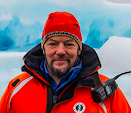New York: St. Martin’s Press, 2022
412 pp: $29.99
Reviewed by Lawrence Millman
As a polar drama, the 1913 Karluk story doesn’t have the celebrity status of the Shackleton Endurance saga, but it’s a no less remarkable tale. The two major players were Captain Bob Bartlett and explorer Vilhjalmur Stefansson. The latter purchased the Karluk, an ill-equipped brigantine, in order to explore the Beaufort Sea, and when the ship got stuck in the ice off northern Alaska, he headed to the mainland to hunt caribou, although there weren’t caribou in that part of Alaska. The Karluk soon sank, with Bartlett playing Chopin’s “Funeral March” on a gramophone to accompany its demise. After the crew and scientists ended up on Siberia’s Wrangel Island, Bartlett dogsledded to the mainland, then dog-sledded 700 miles to Komsomolskaya Bay, and then took a boat to Alaska. Time passed. One day a ship appeared off the shore of Wrangel Island. The Karluk’s starving, emaciated, and bedraggled survivors were saved.
In Empire of Ice & Stone, author Buddy Levy takes on the Karluk story, and in order to learn about the expedition, he consulted journals, notebooks, logbooks, and various archives. But rather than "just the facts, ma’am," he invents dialogue and his characters’ inmost thoughts. He also keeps descriptions at a minimum, especially historical and geographical descriptions. Wrangel Island seems always to be “forbidding” and “craggy” or some variation thereof. Levy writes that Nome, Alaska, was founded by the Norwegian Jafet Lindeberg, but not that Nome is a toponym named for several locales in Norway. In the end, the book is like an adventure novel in which the reader eagerly turns the pages to find out who will freeze to death or starve to death next.
And, as it happens, Buddy Levy didn’t visit any of the places in the book. Thus he seldom sees the forest for the trees or, I should say, the dwarf shrubs. In fact, he doesn’t see the dwarf shrubs, either. For there’s no mention of the fact that Wrangel has a large number of endemic plants, some of which must have been good for foraging, as the island was probably the last refuge in the world for woolly mammoths (he doesn’t mention this, either). One of the plants has a flower which brought hope to the Karluk’s despairing survivors. Levy makes no attempt to identify the flower, only to say that it’s purple (it was probably purple saxifrage). The survivors eat several polar bears, but there’s no reference to the fact that Wrangel has the largest density of denning polar bears of anywhere in the world. Indeed, several of those survivors died not from eating tainted pemmican, as Levy suggests, but probably from trichinosis as a result of having eaten undercooked polar bear meat. Yes, I know: the book is about an Arctic expedition, not the natural world. But I dare say you can’t write about an expedition like this one without describing the environment where it takes place.
What I’ve referred to in the previous paragraph is a common malady nowadays. Authors who write books about the Arctic seem disinclined to go there. Instead, they surf the web, read other books and texts, visit an archive or two, and voila! out comes their book. Small wonder that words like “desolate,” “craggy,” “barren,” or “forbidding” are repeatedly used to describe Arctic habitats. Here I should mention that the previous book about the Karluk expedition, Jennifer Niven’s The Ice Master, suffers from the same malady as Levy’s book. Ms. Niven didn't' visit the Arctic herself until after her book was published, and this is obvious throughout her narrative. Certain readers might argue that these books aren’t really about the Arctic, but about human survival. To repeat myself, you can’t write about human survival without depicting the habitat where those humans are trying to survive.
Even so, Empire of Ice & Stone is a page turner. Bartlett’s heroism is duly noted, as is Stefansson’s self-absorbed behavior. But if you want to read a really good book about the Karluk expedition, you should procure a copy of William Laird McKinley’s The Last Voyage of the Karluk. McKinley, otherwise known as “Wee Willie” (he was 5’4” tall), was one of the ship’s survivors as well as one of its scientists. What he says about Captain Bartlett, Vilhjalmur Stefansson, and his own vicissitudes on Wrangel Island rings powerfully with the truth.



No comments:
Post a Comment